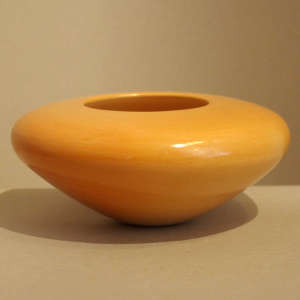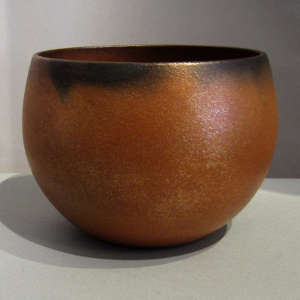Design Elements: Firing Effects

Highly polished red clay body turned black in an oxygen-reduction atmosphere
by Effie Garcia, Santa Clara 3.5 in H by 5.25 in Dia
Pottery is usually fired in the open, or in a shallow pit, using cow or sheep manure and/or wood or bark for fuel. The length of the firing, the final temperature, the rapidity of cooling and the firing atmosphere - either oxidization or reduction (reduced oxygen) - affects the finished surface color of the ceramic vessels. Then again, something that turned black in an oxygen-reduction atmosphere can be reheated, re-oxygenated and turned red again. Or the original oxygen-reduction burn could be more closely monitored and the pot removed in any of the color stages between red and black... Many of the younger potters of Santa Clara Pueblo have become highly skilled at this and regularly produce pottery with sienna spots and rims by reheating parts of a black pot with a blowtorch or by setting a pot on its rim on a hot cookie sheet. Others know exactly when to pull a red-body pot from an oxygen-reduction fire to get a brown surface as a background for their sgraffito work. At least one potter I know uses strips of aluminum foil on his pieces to prevent the carbon in the oxygen-reduction atmosphere from touching the clay and turning it black. Those place where the foil was applied remain red through the firing and don't need to be treated again afterward with a blowtorch.
Fire clouds are also a coloring event that occurs during firing. Generally it happens when something burns too close to the pot or actually touches it. It also happens when smoke touches the piece, like on a windy day. This is seen on a lot of Hopi and Diné pottery with many Diné potters placing their wood in such a way as to encourage fire clouds (some just cook their pots in their kitchen wood stove). Some of the black pottery produced at Santa Clara and San Ildefonso is spotted, indicating a piece had ashes fall on it in the flames. Some potters isolate their pieces inside an upside-down metal can and build their fires around it. Others use a metal crate to keep the fire off without keeping the smoke away.
Firing is the proof of a potter's skill because after all the work that goes into making a pot, it's in the firing that the pot actually becomes a pot or it explodes (literally). And if it explodes, how many other pots might it take with it in the explosion? Some potters will only fire one or two pieces at a time while others will stack up pieces and cook twenty or more at once.
Maria Martinez knew her clay so well she would sometimes fire multiple stacks of pieces at a time, and lose none. Her son, Popovi Da, studied the dynamics of the firing process so well he learned how to make black pots look like they were composed of gunmetal. Where previously, the gunmetal effect happened by accident, he was able to achieve it consistently.
At Santa Clara there seems to be a competition among the potters to see who could consistently make the deepest and glossiest black pots. In researching that I entered into discussions of the various qualities of manures available to them (I've been told by a couple sources that the manure of Arabian horses is the best they've found, so far...)
Pre-contact, Hopi potters often used lignite coal, found in layers among the sandstones of their mesas, to do their firing. The Spanish hadn't brought manure to the New World yet and they had a severe shortage of usable wood, although many today still use strips of cottonwood and cedar bark as some of their ancestors did. The use of their coal required them to do their firing within a few feet of their coal mine as the coal disintegrated quickly when exposed to the open air. The heat of a coal fire also required a different formulation of clay, temper and design materials. Bobby Silas has dedicated himself to relearning that process and make pottery very similar to that made 500 or more years ago.
Firing results also depend on the wind, humidity, fuel, moisture in the soil underneath, moisture and organic materials in the clay of the pot, heating of the piece just prior to firing (many potters have told me they heat their pieces in the oven before putting them in the fire), outdoor temperature... all figure in the equation. That said, some potters from Mata Ortiz, Acoma, Laguna and most from Zuni now use electric kilns to fire their pieces.
In some families, the presence of an outsider at the firing pit is felt to be enough bad juju to destroy things in the firing pit. I guess that might be a firing effect, too, kinda like singing the wrong prayers at the wrong stage in the process. Those folks refuse to fire when strangers are around. We have to keep in mind that among all the pueblos, the making of pottery is Sacred Work and Clay Mother is ever-present.
When the Anglo artist Michael Hawley (also known as "Chakoptewa") learned how to make Hopi-Tewa pottery, he was partially adopted into the tribe but he was required to source his own clay and pigments, use designs that no one else was using and fire his pots with coal, just like in the old days. He was successful in his quest and he produced some really interesting work. But it's not "Hopi" as he did not know the prayers that should be uttered while doing the work: that spirit is not in the clay.
Mata Ortiz is different. There was a 500-year break between the ancient Clay-Mother/Flower-World-Complex-religious potters of the era and the modern pottery artists who practice other religions while copying designs and shapes developed by the ancients.

Sienna rim on a black jar with sgraffito butterfly, avanyu and geometric design
by Candelaria Suazo, Santa Clara
3.5 in H by 5.25 in Dia

A lightly carved and sgraffito parrot, dragonfly and geometric design on a black jar
by Martin Olivas, Mata Ortiz
5 in H by 4.25 in Dia
Measurement includes stand




